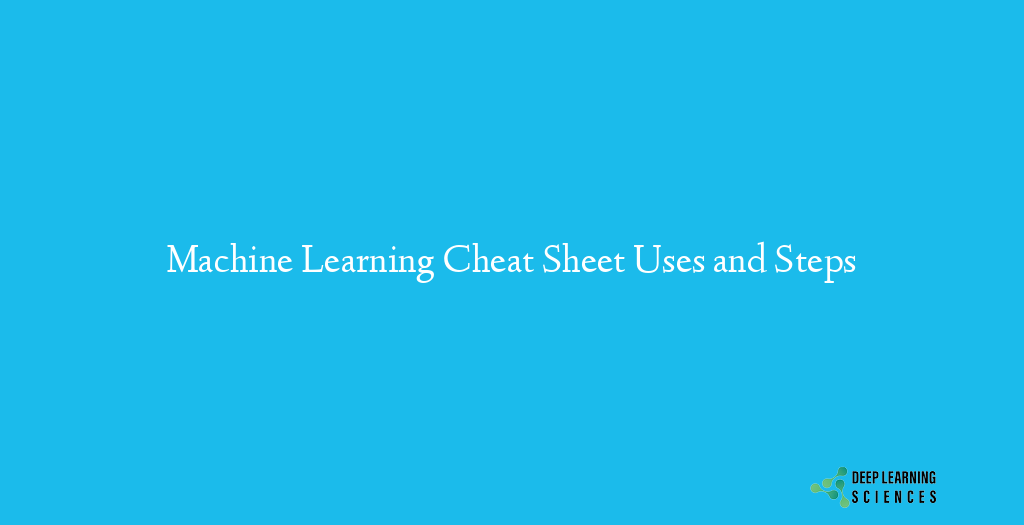ML Machine Learning cheat sheet has a large library of algorithms from the recommender systems, classification, regression, clustering, anomaly detection, and text analytics families. Each is designed to address a different type of machine-learning problem.in ML (Machine learning) few helpful process tables and maps of ML (Machine learning) algorithms are available. Only the most important and complete ones were selected for the conclusion.

Machine Learning Step:
- Collecting Data.
- Preparing the Data.
- Choosing a Model.
- Training the Model.
- Evaluating the Model.
- Parameter Tuning.
- Making Predictions.
The Machine learning algorithms have been sorted into nine groups:
- Anomaly Detection
- Association Rule Learning
- Classification
- Clustering
- Dimensional Reduction
- Ensemble
- Neural Networks
- Regression
- Regularization
Anomaly Detection:
There are 3rd main classes of anomaly detection techniques is following.
- unsupervised,
- semi-supervised
- Supervised.
Supervised Learning
Models used in ML supervising seek to generalize patterns discovered in previously seen raw and facts on unseen data by mapping inputs to outputs. Regression model where we attempt to forecast a continuous variable such as classification models or stock price. Attempt to predict a binary (0-1) or multi-class factor, such as whether and not a customer would churn are two basic examples of supervised learning Machine models. two well-liked supervised machine learning model categories in the section below.
- linear models
- Tree-based models.
A Linear Model
The linear models provide a best-fit line or best outer line. According to the linear model, outputs are just a linear combination of different characteristics. Linear models in machine learning, along with the benefits and drawbacks.
Regular Regression
A straightforward formula for simulating the linear relationship between an output variable or input and a continuous target.
Applications
- Stock Price Forecast
- Estimating housing price trends
- Customer lifetime value forecasting
Advantages
- Explicit procedure
- Results or information that can be understood by the output coefficient
- More quickly trained than alternative ML (machine learning) models
Disadvantages
- Assumes that inputs and outputs data are linear.
- Observant of anomalies
- Can underfit with low-dimensional, small-scale data sets.
Tree-based Models
The tree-based models of machine learning extrapolate predictions from decision trees using a set of if-then many rules. The linear models in machine learning, along with their benefits and drawbacks.
Also Read: Dynamodb Vs Cassandra: Pros and Cons
Decision Tree
The decision Tree model provides the predictions by applying decision rules to the features. it can be applied to both classification and regression.
Applications
- Forecast for customer churn
- Modeling of credit scores
- Disease prognosis
Advantages
- Explicit and comprehensible
- Accepts missing values
Disadvantages
- Tendency to overfit
- Observant of anomalies
Unsupervised Learning
Unsupervised learning is to identify broad trends in input and output data. The most illustration is the clustering or segmentation of customers. This kind of segmentation is generally applicable and has wide many ranges of applications, including for papers, genomes, and businesses. Clustering methods in machine learning which learn to group related data points together or association algorithms, which combine various data points according to pre-established rules examples of unsupervised learning.
Clustering Models
K-Means
The most popular clustering method is K-Means in machine learning which establishes K groupings based on the euclidean distances of the model.
- Segmenting customers
- Systems of recommendations
Advantages
- Supports big datasets
- Simple to use and understand
- Produces compact clusters
Disadvantages
- Required the anticipated number of clusters from the start
- Possesses issues with a range of intensities and cluster sizes
Association
A rule-based method that uses the prior study of the characteristics of frequent item sets to identify the most item sets in a given dataset.
Applications
- Product insertions
- Engine recommendations
- Optimization of advertising
Advantages
- Results are perceptible and comprehensible
- Exhaustive technique since it unsafe all laws based on support and confidence
Disadvantages
- Creates a lot of dull item data sets
- Memory and computation-intensive.
- This leads to a lot of overlapping item data sets
Dimensional Reduction
- Feature selection.
- Feature extraction.
- Principal Component Analysis (PCA)
- Non-negative matrix factorization (NMF)
- Linear discriminant analysis (LDA)
- Generalized discriminant analysis (GDA)
- Missing Values Ratio.
- Low Variance Filter.
How to use the ML (Machine Learning) Algorithm Cheat Sheet?
The Machine learning algorithm cheat sheet is approximate rules-of-thumb. Some can be flagrantly violated, and some can be bent. The machine learning cheat sheet is intended to suggest a starting point. Do not be afraid to run a head-to-head competition between several algorithms models on your data. There is simply no substitute for understanding the principles or rules of each algorithm and the system that generated your data.
Every ML (machine learning) algorithm has its inductive bias or own style. For a specific problem, several machine learning algorithms may be appropriate, and one algorithm may be a better fit than as compare to other. But it is not always possible to know beforehand which is the best fit. In cases like these, several machine learning algorithms are listed together in the cheat sheet. A strategy would be to try one machine learning algorithm, and if the results are not yet satisfactory.